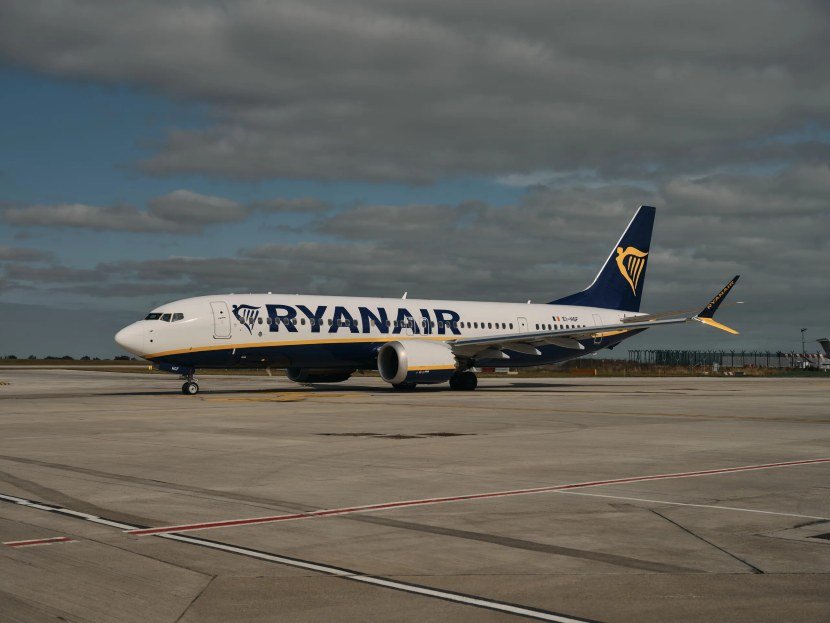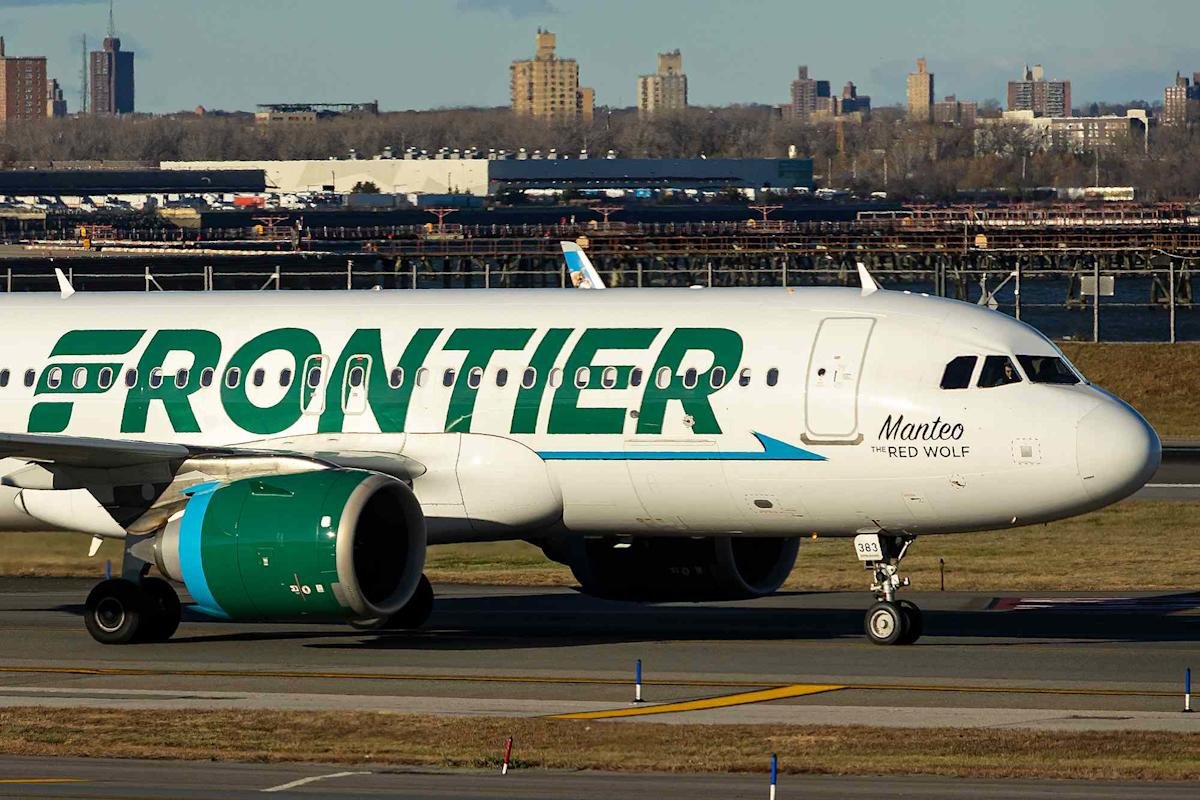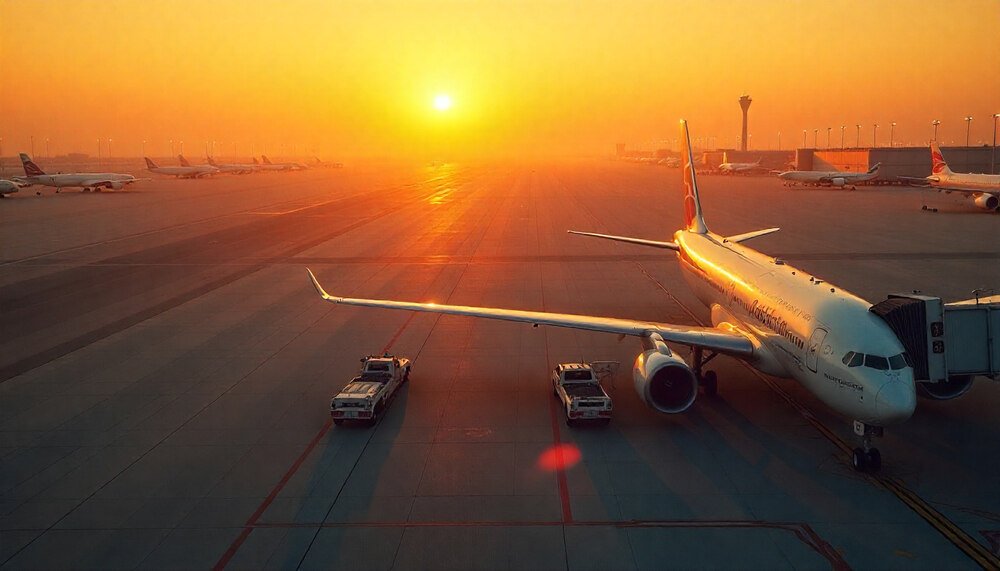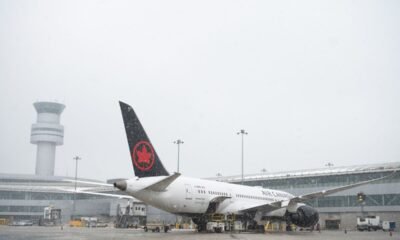Flight Buzz
Travel To Spain Is On Edge! Ryanair Flights Suffering Massive Delays, How Strike Disrupts Madrid, Alicante, Seville, and Key Airports You Need To Know

Wednesday, August 6, 2025
Travellers heading to and from Spain and also Seville, Valencia, Tenerife, Madrid South during the busy August holiday season might run into flight delays this year.
Ground staff from Azul Handling, an important provider for Ryanair, plan to strike for three days, from August 15 to August 17, 2025. The stoppage could disrupt hundreds of Ryanair flights at the country’s biggest airports.
Strike Details: A Threat to Spain’s Tourism Industry
Azul Handling provides essential ground services such as baggage handling, aircraft refueling, and boarding management for Ryanair at several key Spanish airports. The strike, called by the UGT union with backing from CGT, is expected to cause major disruptions at airports across Spain, particularly during peak travel times. The affected airports include Madrid, Barcelona, Malaga, Alicante, Seville, Valencia, Palma de Mallorca, and Tenerife South.
The work stoppages are planned for three peak travel windows each day:
- 05:00–09:00
- 12:00–15:00
- 21:00–23:59
This disruption comes at a crucial time for Spain’s tourism industry, with the August holiday period being one of the busiest for international travel. Tourists and locals alike will be impacted by the expected delays and cancellations, potentially affecting vacations and tourism experiences.
Impact on Ryanair Flights and Passenger Experience
Ryanair has acknowledged the strike but reassured passengers that it does not anticipate significant delays. However, the airline’s statement highlights that ground services are essential for the smooth operation of flights. The strike may lead to delays in baggage handling, aircraft refueling, and passenger boarding, which could have cascading effects on Ryanair’s flight schedule.
Tourists planning to travel during this period are encouraged to monitor their flight status closely and prepare for potential disruptions. Though Ryanair claims minimal impact, passengers should anticipate longer wait times and possible changes to flight schedules.
Compensation Rights for Affected Passengers
Passengers affected by flight delays or cancellations may be entitled to compensation under EU Regulation 261/2004. The regulation grants compensation for delays exceeding three hours or cancellations unless the disruption is due to “extraordinary circumstances.”
The key question regarding this strike revolves around whether it qualifies as an “extraordinary circumstance.” Previous rulings by the European Court of Justice suggest that strikes by subcontracted staff, such as those employed by Azul Handling, may not necessarily exempt airlines from compensating passengers. If the strike leads to significant disruption, Ryanair passengers may be eligible for compensation, depending on the specific circumstances of their delay or cancellation.
What Tourists Should Do to Minimize Disruption
Tourists travelling to Spain during the strike period should take proactive steps to minimise the impact of any disruption. Here are a few key recommendations:
- Check Flight Status: Always check the status of your Ryanair flight on the airline’s website or mobile app before arriving at the airport.
- Arrive Early: Given the potential for delays, arriving early will ensure you have ample time for any unexpected changes.
- Prepare for Alternative Plans: If your flight is delayed or cancelled, explore alternative routes or departure times with Ryanair or other airlines.
- Know Your Compensation Rights: Familiarise yourself with your rights under EU Regulation 261/2004 to ensure you claim compensation if necessary.
Looking Ahead: The Long-Term Impact on Spanish Tourism
If strikes go ahead and delays pile up, Spain’s tourism sector could feel the heat. Summer is peak travel time, especially for visitors from the UK and across Europe, and serious hold-ups can lead to unhappy travelers. That wave of complaints can linger and harm Spain’s image as the first choice for a getaway. To keep visitor trust, the Spanish government and tourism agencies might have to jump in with extra services or public messages to ready travelers and ease any panic.
Tourism is the backbone of the Spanish economy, and a choke in flights by Ryanair, which serves many key routes, won’t stop with the airlines. Hotels, restaurants, and shops in tourist areas depend on the arriving traffic, so a messy travel schedule can ripple out, squeezing local incomes. Smooth flights, then, are not just about planes in the sky; they’re about keeping the whole tourism chain and Spain’s economy sky-high.
Image credit- Ryanair
Flight Buzz
Frontier Airlines CEO Issues Bleak Warning About the Future of Domestic Air Travel — Including Costs and Convenience

Nicolas Economou/NurPhoto via Getty
Frontier Airlines plane
-
Frontier Airlines CEO Barry Biffle warned that domestic airline travel may get less convenient and more expensive for travelers
-
He made the comments during the airline’s recent second-quarter earnings call
-
Biffle said domestic flights are not profitable for airlines due to a lack of demand, compared to the supply
Frontier Airlines CEO Barry Biffle has issued a bleak warning about the future of affordable airline travel.
“There’s going to continue to be reductions in capacity in this industry,” Biffle said during the company’s second-quarter earnings call on Aug. 5, per The Economic Times.
Biffle added that airlines will likely be forced to cut the number of flights and routes they provide to travelers, as many domestic-focused ones are proving unprofitable, The Street reported.
This would ultimately translate to fewer flight options and fewer budget fares for customers.
https://people-app.onelink.me/HNIa/kz7l4cuf
“I’m talking about domestic fares in the domestic marketplace,” Biffle said on the call. “We believe that the entire industry is not making money […] The domestic [side] is not making money. And that’s because there is too much supply relative to demand.”
While the budget airline made $929 million in profit in their second quarter of 2025, the airline had a net loss of $70 million, the company’s public financial records show.
Spencer Platt/Getty
Travelers at JFK International Airport in N.Y.C.
United Airlines CEO Scott Kirby made similar comments about the lack of profitability of current airline models during the company’s second-quarter earnings call as well, per The Street.
Kirby said, “If I dig deeper into it and I look at every airline that’s not named United or Delta, I can find at every single one of them, a double-digit percentage of their route network that loses money. And the only way for them to get margins that are anywhere close to their [wholesale acquisition cost] is to stop flying places that lose money. And that is going to ultimately happen.”
The PEOPLE Puzzler crossword is here! How quickly can you solve it? Play now!
However, not all airline execs are in agreement over the pessimistic prognosis of the industry.
American Airlines CEO Robert Isom addressed Kirby’s comments during his company’s second-quarter call, stating, per Forbes, “We don’t run our airline based on other airlines’ perception of our business.”
And while Islom acknowledged the “reluctance of domestic travelers” to get more involved in the more profitable international travel “game,” he added, “We think that’s going to change.”
Never miss a story — sign up for PEOPLE’s free daily newsletter to stay up-to-date on the best of what PEOPLE has to offer, from celebrity news to compelling human interest stories.
These discussions come at a time when the airline industry has been under much public scrutiny. Back in March, CNN reported that the “fear of flying” had driven down ticket sales in recent months, after several high-profile plane crashes.
Flight Buzz
Booking Flights At 2 AM Will Save You Big Time

At some point, you’ve probably heard that booking flights at 2 a.m. is the secret to finding the cheapest deals. It’s a popular tip that has been circulating by word of mouth and social media for years. But is this advice true, or is it just another believable travel myth? It actually falls somewhere in the middle.
Airfare pricing isn’t random. It’s determined by artificial intelligence (AI) and machine learning systems that adjust prices in real time based on several factors that can change at any moment. While searching in the middle of the night doesn’t guarantee you’ll find the lowest fare, there are a few reasons why late-night searches can work in your favor.
Here are the real reasons why flight prices change, and how night owls might get lucky with a cheap fare if they know what to look for.
Late-Night Flight Searches May Beat The Algorithm
Airlines use dynamic pricing, a strategy that changes ticket prices in real time based on things like demand, competition, and seat availability. These factors can shift quickly, which is why flight prices often change throughout the day.
According to a report from NBC News, because of this strategy, the number of people actively searching for flights can influence pricing. When fewer people are browsing a specific route, prices may dip due to lower demand. On the other hand, if a large number of users are searching for the same destination, even if they’re not booking, it can trigger an increase in fare prices, simply because the system registers a surge in interest.
That’s why booking in the middle of the night, like at 2 a.m., can work in a traveler’s favor. With fewer people online and most corporate bookings happening during business hours, there’s less competition for fares and less activity stimulating the pricing algorithm.
Late-night searches for flights can also line up with airline flash sales – many of which drop just before or after midnight.
Flash Sales Tend To Launch At Midnight
A man and woman booking flight tickets on a laptop.
Many travelers have probably come across a website late at night that’s down for maintenance. This is because companies often schedule updates during off-peak hours, which would include 2 a.m. Airlines follow the same logic when launching flash sales. These limited-time deals offer steep discounts on select routes, are designed to create urgency, and often go live right around midnight.
By rolling out deals when internet traffic is low, airlines can prevent their sites from slowing down or crashing. Midnight is often the start of a new pricing day in many airline systems, which is when scheduled fare updates or flash sales may go into effect. But because airlines operate across multiple time zones, what counts as “midnight” varies. In other words, these updates might appear at different times depending on where you’re searching from.
This is why timing is important in this case. If a sale launches at midnight and only a handful of discounted seats are available, you may still have a chance to grab one by searching shortly after. To improve the odds of booking a flash deal, travelers should find out the airline’s local time zone, set fare alerts in advance, and book directly through the airline’s website instead of on third-party platforms.
Third-Party Booking Sites Can Help Travelers Snag Leftover Deals
The Skyscanner app on a smartphone.
Online travel agencies (OTAs) like Booking.com, Expedia, Google Flights, and Skyscanner are great for comparing fares across multiple airlines, but they don’t always have the most up-to-date prices listed. If you’ve ever clicked on a great deal only to see a higher price at checkout, you’ve experienced this delay in real time.
OTAs use Application Programming Interfaces (APIs) to pull pricing data directly from the airlines. However, depending on the software and how often the data refreshes, the updates don’t always sync right away. As a result, travelers might see a lower fare that’s already changed on the airline’s website.
These leftover fares usually don’t last long, but travelers may be able to book the deal before the system catches up. However, it’s important to keep in mind that the fare might disappear at checkout if it’s already expired.
Does the Day You Book Flights Still Matter?
calendar with pins on certain days
For years, travelers have been told to book flights on a Tuesday to get the best deals. But according to a TikTok video from @cnbcselect, the day you book your flight doesn’t really matter anymore. Because of dynamic pricing and real-time fare updates, cheap tickets can appear any day of the week.
What does matter is the day of the actual flight. Mondays and Fridays tend to be more expensive since business travelers prefer these days. On the other hand, flights that leave on Tuesdays, Wednesdays, and Thursdays are usually cheaper because demand is lower. The time of day a flight leaves also affects the price. Early morning flights are often less expensive because most people don’t want to wake up early to catch them.
Finally, travelers should follow the “21-day rule,” which says that three weeks before departure is the latest anyone should book a flight to minimize unexpected price increases. After the 21-day mark, airlines often raise fares as travel dates get closer.
While there’s no longer a “best day” to purchase a flight ticket, the idea of booking it at 2 a.m. does hold some truth. Booking flights can seem like a guessing game, but understanding how the system works can give you an advantage while searching for the best deal.
Flight Buzz
Saudi Arabia Sets Revolutionary Aviation Benchmarks During Hajj 2025, Efficiently Handling Over 140,000 Flights in a Brilliant Display of Operational Mastery

Published on
August 9, 2025 |
Saudi Arabia has achieved an extraordinary feat during Hajj 2025, shattering global air traffic records by managing over 140,000 flights, marking a groundbreaking 8% increase from the previous year. The Kingdom orchestrated a seamless flow of air traffic, effectively handling a monumental number of domestic and international flights, underscoring its dominance in global aviation. This remarkable achievement highlights Saudi Arabia’s unmatched precision and operational excellence in facilitating one of the largest annual religious events in the world. With a record 2,338 air movements in a single day, the Kingdom has set new standards in air traffic management, solidifying its leadership as a vital global aviation hub. Through strategic planning and cutting-edge technology, Saudi Arabia has demonstrated its unwavering commitment to ensuring a safe, smooth, and efficient pilgrimage experience for millions of Muslims worldwide.
Saudi Arabia achieved a historic milestone during the 2025 Hajj season, successfully managing over 140,000 air movements, marking an 8% increase compared to the previous year. This remarkable feat highlights the Kingdom’s commitment to streamlining logistics and enhancing air traffic operations, ensuring a smooth pilgrimage experience for millions of Muslims worldwide.
A Surge in Air Traffic
The 2025 Hajj season (Hajj 1446 AH) witnessed record-breaking air traffic, with more than 140,000 flights handled by Saudi Arabia’s airspace. These flights consisted of both domestic and international air movements, underlining the Kingdom’s essential role in facilitating the pilgrimage. The Saudi Air Navigation Services (SANS) coordinated air traffic for 213 airlines, further reinforcing Saudi Arabia’s global connectivity and importance as a key aviation hub for religious tourism.
Key Highlights of Air Traffic Operations
- Single-Day Peak: On Dhu Al-Hijjah 2, 1446 AH, Saudi Arabia achieved a new record for air traffic, with 2,338 aircraft movements in a single day. This marked a 4% increase over the same day in 2024, showcasing the Kingdom’s growing air traffic capacity.
- Arrival and Departure Phases:
- Arrival Phase: During the period from Dhu Al-Qidah 1 to Dhu Al-Hijjah 8, there were 74,902 air movements, representing a 15% increase over the previous year. This reflects a significant surge in the number of incoming flights as millions of pilgrims arrived in the Kingdom for Hajj.
- Departure Phase: From Dhu Al-Hijjah 23 to Muharram 15, Saudi Arabia recorded 66,072 air movements during the departure phase, showing a 2% increase compared to 2024.
These figures demonstrate the Kingdom’s ability to handle substantial air traffic volume, with arrivals seeing a particularly impressive increase in comparison to the previous year.
Advanced Operational Strategies and Technology
The success of Saudi Arabia’s air traffic management during Hajj 2025 can be attributed to advanced technological infrastructure and highly skilled personnel. The Saudi Air Navigation Services company (SANS) deployed sophisticated air traffic management systems, ensuring seamless operations despite the high volume of air movements. This technological infrastructure was paired with highly trained air traffic controllers, engineers, and maintenance teams, all working together to ensure the safety and efficiency of each flight.
Furthermore, Saudi Arabia’s airspace management allowed for smooth and coordinated air traffic flows across all major airports in the Kingdom, facilitating the swift and safe arrival and departure of millions of pilgrims from various parts of the globe.
Saudi Arabia’s Growing Role in Global Aviation
The record air traffic numbers during the Hajj season also reflect Saudi Arabia’s growing role in global aviation. By coordinating with 213 international airlines, the Kingdom further established itself as a central hub for international air travel. This broad international participation underscores Saudi Arabia’s increasing influence in global aviation, making it a key gateway for pilgrims from around the world.
As the Kingdom’s aviation infrastructure continues to improve, Saudi Arabia’s connectivity to global airlines grows stronger, expanding its reach as a leading air transport hub. The Kingdom’s strategic location between continents also plays a pivotal role in facilitating smooth air traffic operations, benefiting both religious pilgrims and international travelers.
Ensuring a Seamless Pilgrimage Experience
At its core, the success of Saudi Arabia’s air traffic management during Hajj 2025 is driven by the Kingdom’s commitment to providing a safe, smooth, and efficient pilgrimage experience for Muslims worldwide. The 140,000 flights, including the record-breaking 2,338 aircraft movements in a single day, demonstrate Saudi Arabia’s preparedness and capacity to handle large-scale religious events.
The operational excellence displayed during the Hajj season not only benefits the logistics of the pilgrimage but also contributes to the spiritual journey of millions. The efficient air traffic flow ensures that pilgrims can focus on their religious duties without concerns about travel-related disruptions.
Looking Ahead: Preparing for Future Hajj Seasons
The remarkable success of Hajj 2025 sets a new benchmark for the Kingdom in terms of air traffic management. As Saudi Arabia continues to modernize its air navigation systems and infrastructure, it is poised to handle even greater volumes of traffic in future seasons.
The strategic role of Saudi Arabia in global air traffic will continue to grow as the Kingdom enhances its international partnerships with airlines and expands its technological capabilities. With future Hajj seasons expected to draw even more pilgrims, Saudi Arabia’s ability to manage air traffic efficiently will be crucial to ensuring the safety and success of the pilgrimage.
In conclusion, Saudi Arabia’s achievement in handling over 140,000 flights during Hajj 2025 not only showcases its operational excellence but also underscores the Kingdom’s importance as a global hub for air travel. The continued development of Saudi Arabia’s aviation infrastructure will only further cement its position as a leader in religious tourism and international air connectivity.
-

 Brand Stories3 weeks ago
Brand Stories3 weeks agoBloom Hotels: A Modern Vision of Hospitality Redefining Travel
-

 Brand Stories2 weeks ago
Brand Stories2 weeks agoCheQin.ai sets a new standard for hotel booking with its AI capabilities: empowering travellers to bargain, choose the best, and book with clarity.
-

 Destinations & Things To Do3 weeks ago
Destinations & Things To Do3 weeks agoUntouched Destinations: Stunning Hidden Gems You Must Visit
-

 Destinations & Things To Do2 weeks ago
Destinations & Things To Do2 weeks agoThis Hidden Beach in India Glows at Night-But Only in One Secret Season
-

 AI in Travel3 weeks ago
AI in Travel3 weeks agoAI Travel Revolution: Must-Have Guide to the Best Experience
-

 Brand Stories1 month ago
Brand Stories1 month agoVoice AI Startup ElevenLabs Plans to Add Hubs Around the World
-

 Brand Stories4 weeks ago
Brand Stories4 weeks agoHow Elon Musk’s rogue Grok chatbot became a cautionary AI tale
-

 Brand Stories2 weeks ago
Brand Stories2 weeks agoContactless Hospitality: Why Remote Management Technology Is Key to Seamless Guest Experiences
-

 Asia Travel Pulse1 month ago
Asia Travel Pulse1 month agoLooking For Adventure In Asia? Here Are 7 Epic Destinations You Need To Experience At Least Once – Zee News
-

 AI in Travel1 month ago
AI in Travel1 month ago‘Will AI take my job?’ A trip to a Beijing fortune-telling bar to see what lies ahead | China













You must be logged in to post a comment Login